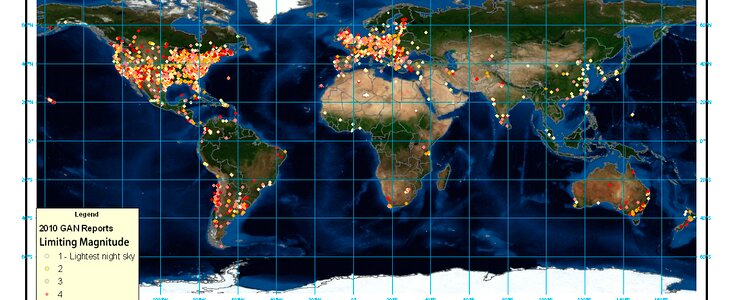Wasted Lights And Wasted Nights: Globe At Night Tracks Light Pollution
17 March 2011
Poorly-aimed and unshielded outdoor lights are more than an annoyance. They waste more than $2 billion (17 billion kilowatt-hours) of energy in the United States each year. Poorly shielded roadway lights are also a safety and glare hazard, especially for older citizens. Under an unpolluted sky we ought to see more than 2000 stars, yet we see less than a hundred from many cities. The Milky Way is unknown to most city dwellers.
GLOBE at Night is an international campaign run each spring for the last six years by the National Optical Astronomy Observatory in Tucson. The program invites citizen scientists to track outdoor lighting levels and submit their observations to a website from a computer or smart phone. The campaign runs March 22 through April 4 in the northern hemisphere and March 24 through April 6 in the southern hemisphere. Over the last six annual 2-week campaigns, citizen scientists from more than 100 nations have contributed 61,000 measurements (Figure 1). The night sky brightness can be measured by anyone using a simple star map provided by the project. The measurements provide a valuable resource for teachers, scientists, city planners, and policy makers to track and address wasted light/energy issues.
"Monitoring our night sky by citizen scientists is invaluable in identifying areas where the glare of unshielded lighting may be hazardous and where energy is being wasted." said GLOBE at Night Director, Dr. Connie Walker of the National Optical Astronomy Observatory. "All it takes is a few minutes for a family to measure their night sky brightness by noting how many stars are missing from an easy-to-find constellation like Leo (in the northern hemisphere) or Crux (in the southern hemisphere). This tells us how much light is directed upwards into the sky."
Across the country, people are recording the night sky brightness level in their neighborhoods. This information can be used in local decisions on how to increase safety, lower energy consumption, and protect human health-areas affected by high levels of extraneous light. These observations will also help identify parks suitable for urban "sky oases"- places that can be developed to help city dwellers appreciate the night sky from a safe, dark place.
The GLOBE at Night program motto is "Less of Our Light for More Star Light: Saving Energy, Saving our Night Skies." Walker feels strongly that the program is most important in cities far from telescopes and observatories. "We need to improve our outdoor lighting fixtures and practices; many of our current lights waste a tremendous amount of valuable energy and the beauty of our night sky. Thanks to thousands of citizen scientists participating in GLOBE at Night, we are working to preserve both of these important resources."
To learn more, visit the program's website: www.globeatnight.org. GLOBE at Night is also now on Facebook and Twitter.
More information
GLOBE at Night is an educational program of the National Optical Astronomy Observatory (NOAO), in partnership with the Environmental Systems Research Institute, Inc. (ESRI), the International Dark-Sky Association (IDA), Centro de Apoyo a la Didactica de la Astronomia (CADIAS) (Chile) and the Global Learning and Observations to Benefit the Environment (GLOBE) Program.
NOAO is operated by the Association of Universities for Research in Astronomy Inc. (AURA), under a cooperative agreement with the National Science Foundation.
Contacts
Dr. Constance E. Walker
National Optical Astronomy Observatory
952 N. Cherry Ave. Tucson, AZ 85719, USA
Tel: 520.318.8535
Cell: 520.331-2448
Email: cwalker@noao.edu



